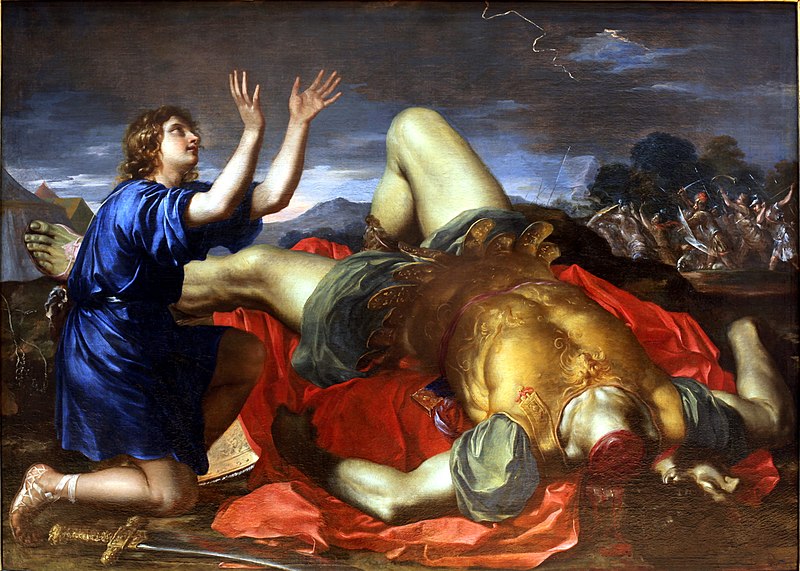
Among the many stories of warfare that are described in the Hebrew Bible, perhaps the most famous is the epic battle between David and Goliath (1 Samuel chapter 17). David, still a shepherd boy living in Bethlehem, is able to fell the greatest Philistine warrior with a mere stone. Most readers of this story have focused on the fascinating physical details of the victory: Just how large was Goliath? What did his armor look like? Is it possible to kill a man of this size with a small stone between the eyes? In this post, I would like to set aside these intriguing questions in order to examine another aspect of this story: the location of the battle. The story begins with a deatiled account of the location:
Now the Philistines gathered their forces for war and assembled at Socoh in Judah. They pitched camp at Ephes Dammim, between Socoh and Azekah. Saul and the Israelites assembled and camped in the Valley of Elah and drew up their battle line to meet the Philistines. The Philistines occupied one hill and the Israelites another, with the valley between them. (1 Samuel 17:1-3)
Why is it significant that this battle happened in this particular place?

The Valley of Elah is located in a region called the Shephelah of Judah. The word Shephelah (שפלה) comes from the Hebrew root Sh-F-L (שפל) meaning: low, humble, or even humiliated, dejected. From the perspective of the Judahite inhabitants of the Central Hill Country – which is the dominant voice in the Hebrew Bible – this region is certainly lower, pushed down. You can see in the photo above what the foothills in this region look like. Rolling, low hills. Nothing too tall, but certainly not the flat Mediterranean Coastal Plain. Here is the modern city of Ashkelon built on the southern end of Israel’s coastal plain. This is the region that became the heartland of Philistia.

For several centuries the Shephelah was the area of friction between two rival powers: Philistines and Judahites. Both populations were relatively recent arrivals to the Land, having emigrated from abroad around the year 1200 BCE. The Philistines originally came from the Aegean. According to Amos 9:7 they came from Caphtor, which is perhaps the island of Crete.

The relief above depicts a large battle scene between the Egyptians and the “Sea Peoples,” who arrived from the Aegean circa 1200 BCE. It is found on the walls of the mortuary temple of Pharaoh Ramses III (1218-1155 BCE) at Medinet-Habu, near Luxor Egypt. There are a total of seven “Sea Peoples” mentioned in Egyptian sources: Peleshet, Shekelesh, Weshesh, Tjekel, Denyen, Sherden, Teresh. This influx of Sea Peoples was the result of a major crisis in the region of the Aegean Sea in the late 13th century, which caused many to seek shelter elsewhere. Many of the mighty ancient civilizations of the Mediterranean collapsed around this time: e.g., Hittites, Minoans, Mycenaeans. First the Philistines invaded Egypt, then were pushed north to the southern coast of Canaan. From their base around Gaza/Ashkelon, the Philistines pushed east and north, all the way up to the Jezreel Valley. Eventually the Kings of Israel (most notably Saul and David) fought them, and pushed them back to the coast. They would control the southern coastal plain for about 500 years, until they were absorbed by the conquering Assyrians.

The mortuary temple of Ramses III at Medinet Habu.
The men in feathered helmets shown below are the Philistines, one of these “Peoples of the Sea” defeated by Ramses III in 1177 BCE. They are being led away from the battlefield as prisoners of war. As a result, the Philistines left Egypt and settled along the southern coastal plain of the Land of Canaan. They then set up a confederation of five powerful city states: Ashdod, Ashkelon, Gaza, Gath, and Ekron. Around the same time, the Israelites came out Egypt and settled in the central hill country. The Shephelah was the strip of low hills which separated them.
So it makes sense that these two populations would come into contact in the Shephelah. But why in the Valley of Elah in particular? Much of this undulating terrain of the Shephelah is difficult to cross, not ideal conditions for a large battle. The five east-west streambeds (wadis) that cross the Shephelah are the exception. They are as follows:
- Ayalon
- Sorek
- Elah
- Guvrin
- Lachish
These five valleys are responsible for evacuating rain water that falls in the Hill Country and depositing it in the Mediterranean Sea. The Elah Valley connects the Philistine city of Gath (Goliath’s hometown) with the Judahite city of Bethlehem (David’s hometown). It changes its name from Nahal Etziona to Nahal HaElah, but it is essentially the same wadi. It is a rare example of a wide open valley, not a narrow meandering canyon, as many of the other wadis are. It also has “stadium seating” on both sides because it is surrounded by hills. So it makes perfect sense that the battle should have occurred here.

Looking north from Neve Daniel towards Jerusalem







[…] Of all the nations that have a bad rap in Western civilization, perhaps none has a more unfavorable reputation than the Philistines. In modern English, we use the term “Philistine” to refer to a crude or uncivilized person, who is “guided by materialism and is usually disdainful of intellectual or artistic value” (Merriam-Webster). The origin of this reputation is found in the Hebrew Bible, where the Philistines are the “bad guys”, the arch-rivals of the Children of Israel. For centuries, the two nations stood in a state of quiet antagonism punctuated by intermittent warfare, such as the famous Battle of David and Goliath. […]
Very interesting and informative. A sense of real history which brings the bible alive.